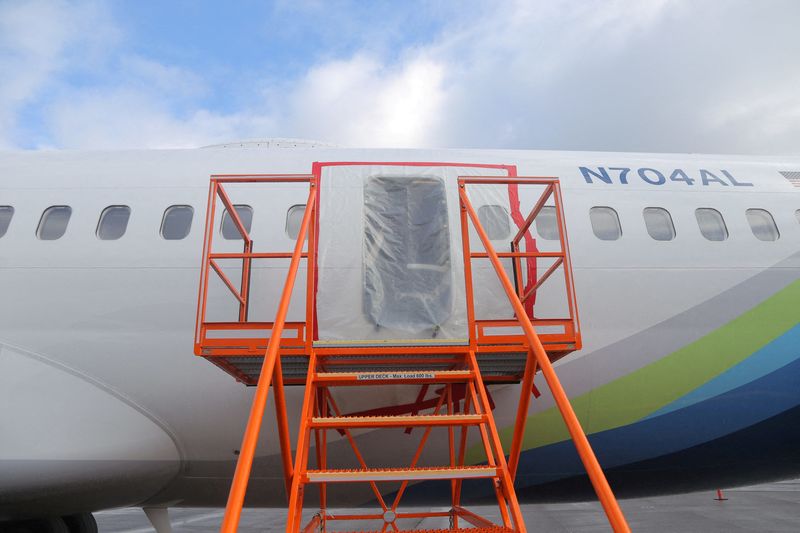By David Shepardson and Allison Lampert
WASHINGTON (Reuters) - The U.S. aviation regulator on Friday extended the grounding of Boeing (NYSE:BA) 737 MAX 9 airplanes indefinitely for new safety checks and announced it will tighten oversight of Boeing itself after a cabin panel broke off a new jet in mid-flight.
As United Airlines and Alaska Airlines canceled flights through Tuesday, the Federal Aviation Administration (FAA) said it will require another round of inspections before it will consider putting the jets back in service.
Under more stringent supervision, the regulator will audit the Boeing 737 MAX 9 production line and suppliers and consider having an independent entity take over from Boeing certain aspects of certifying the safety of new aircraft that the FAA previously assigned to the planemaker.
The FAA said the continued grounding of 171 planes with the same configuration as the one in the incident was "for the safety of American travelers." The regulator had said Monday the grounding would be lifted once they were inspected before saying more work was needed on planned checks.
On Friday, the FAA said 40 of the planes must be reinspected, then the agency will review the results and determine if safety is adequate to allow the MAX 9s to resume flying.
Alaska Airlines and United Airlines, the two U.S. airlines that use the aircraft involved, have had to cancel hundreds of flights in the last week due to the grounding as a widening crisis engulfed the U.S. planemaker.
Alaska and United on Friday both canceled all MAX 9 flights through Tuesday and United canceled some additional flights in the following days.
Boeing shares closed down 2.2% on Friday and are down nearly 12% since the Jan. 5 incident. Confidence in Boeing has been shaken since a pair of MAX 8 crashes in 2018 and 2019 killed 346 people and led Congress to pass sweeping reforms for certification of new airplanes.
The Alaska Airlines aircraft, which had been in service for just eight weeks, took off from Portland, Oregon last Friday and was flying at 16,000 feet when the panel tore off the plane. Pilots flew the jet back to Portland, with only minor injuries among passengers.
On Thursday, the FAA announced a formal investigation into the MAX 9. FAA Administrator Mike Whitaker said the Alaska Airlines MAX 9 had "significant problems" and noted Boeing's history of production issues.
The National Transportation Safety Board (NTSB) is investigating if the MAX 9 jet in the Alaska episode was missing or had improperly tightened bolts.
REGULATOR SEEKS ROOT CAUSES
Whitaker told Reuters Friday he sees the MAX 9 problems as a manufacturing issue, not a design problem. Noting years of production problems at Boeing, he said: "Whatever's happening isn't fixing the problem and requires an extensive review. We are becoming increasingly focused on the manufacturing process."
The FAA wants to see "where these breakdowns could happen. Are there not enough quality control checks? Are they not in the right places? Is the order of assembly creating some issues?," he added.
Boeing pledged on Friday to "cooperate fully and transparently with our regulator. We support all actions that strengthen quality and safety and we are taking actions across our production system."
Boeing supplier Spirit AeroSystems (NYSE:SPR) said Friday it is "committed to supporting the FAA’s audit of production and manufacturing processes."
Whitaker wants to reexamine the long-standing practice of the FAA delegating some critical safety tasks to Boeing.
"I think we should look at third party," Whitaker said. "I think it may be an option where there's a higher level of confidence, where we have more direct oversight ability, and where the folks doing certain critical inspections don't have a paycheck that's coming from the manufacturer."
Alaska and United said preliminary checks found loose parts on multiple grounded aircraft.
Captain Ed Sicher, president of the Allied Pilots Association representing 15,000 pilots at American Airlines (NASDAQ:AAL), said tighter control by the FAA was “inevitable” given Boeing’s problems. Texas-based American flies a different MAX variant.
“I think there’s an increased level of skepticism and scrutiny over what used to be … an excellent brand,” Sicher told Reuters. “Now everyone is starting to raise an eyebrow and make sure the Ts are crossed and the Is are dotted.”
On Wednesday, Boeing CEO Dave Calhoun acknowledged on CNBC that there was a "quality" issue in allowing the MAX 9 to fly with the problem that caused the blowout.
Since the fatal crashes, critics have said strained budgets at the FAA led the agency to delegate too much responsibility to the planemaker. Since 2019, the agency has cut back on the practice.
“The larger question is does the FAA have the staffing to increase oversight for the long term?” said U.S. aviation safety expert John Cox, adding that the creation of third-party entity would be "highly unusual."

In March, the FAA said it boosted staff providing regulatory oversight of Boeing to 107 from 82 in prior years.
In 2021, Boeing agreed to pay $6.6 million in penalties after failing to comply with a 2015 safety agreement. The FAA also launched an outside review of Boeing's safety culture in January 2023.